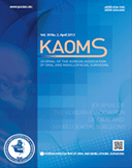Journal of the Korean Association of Oral and Maxillofacial Surgeons
- P-ISSN2234-7550
- E-ISSN2234-5930
- SCOPUS, KCI, ESCI
 ISSN : 2234-7550
ISSN : 2234-7550
A comparative analysis of patients with mesiodenses: a clinical and radiological study
김수관 (조선대학교)
오지수 (조선대학교)
유재식 (조선대학교)
정경인 (조선대학교)
김영균 (서울대학교)
이상호 (조선대학교)
이난영 (조선대학교)
Abstract
Objectives: A mesiodens appears most commonly as a supernumerary tooth impacted in the anterior maxilla. The purpose of this study is analyze mesiodens clinically.Materials and Methods: Gender, crown form, direction of impaction, relation to permanent incisors, and chief complaints of patients with extracted mesiodens were analyzed. Results: Patients were analyzed for motivation to visit the hospital; 85.4% of the patients were referred from other hospitals. Mesiodens was more common in males than in females (3.7:1), and 70.1% of patients had only one mesiodens, while 29.6% had two mesiodenses. Of the mesiodenses, 61.4% were of the aconical form, and the most common direction was upward (62.4%), followed by the normal position (26.0%) and the horizontal position (11.6%). The mesiodenses caused orthodontic problems with the permanent incisors in 46.3% of cases. Mesiodens associated with dentigerous cyst was rarely observed in our patient group.Conclusion: Mesiodens is more common in males than in females and often affects the permanent incisors. Thus, careful clinical and radiological evaluations of mesiodenses are important.
- keywords
- Supernumerary tooth, Tooth abnormalities
- 47다운로드 수
- 142조회수
- 0KCI 피인용수
- 0WOS 피인용수